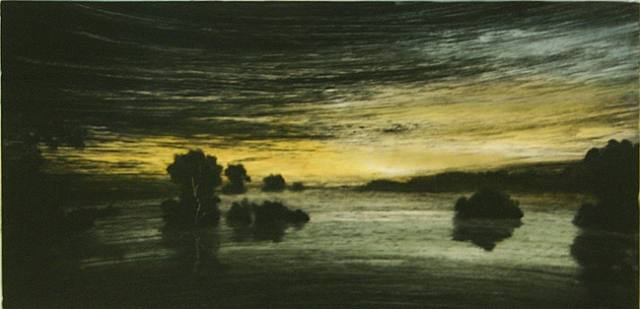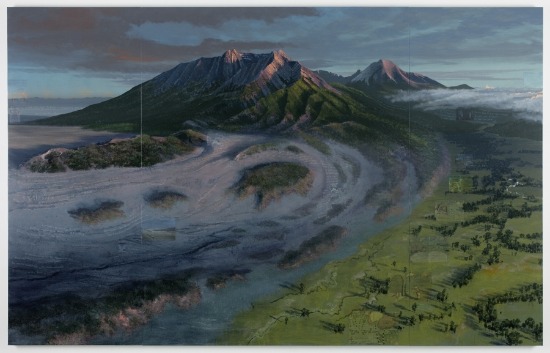
Stephen Hannock, Painter-Conservationist New work installed at DAM
A Stephen Hannock landscape is more than a painting, its a place of discovery, a dimensional plane that invites the viewer to jump in and join the narrative. Hes a documentarian who uses landscape painting to set a stage and tell the story of a place across time.
“Im not Tony Gilroy,” he said via telephone from the Denver Art Museum where Mt. Blanca with Ute Creek at Dawn was dedicated on May 13, 2010. The 80″ x 120″ painting is on a two year loan courtesy of collector and patron Louis Bacon, owner of the Trinchera Ranch in Costilla County near the base of Mt. Blanca.
Mt. Blanca is only the second Western landscape that Hannock has painted. His first was Utah Canyon at Dawn, a large work commissioned by Robert Redford to commemorate the 25th Anniversary of the Sundance Institute. The painting isnt of just any canyon in Utah, but of the valley that Redford purchased with money earned from the film “Butch Cassidy and the Sundance Kid.”
So why Mt. Blanca? Colorado has 54 Mountain Peaks that are 14,000 feet or taller. Why this one?
“Its the closest physical peak Ive seen in our country that resembles Kilimanjaro erupting from the plains seemingly out of nowhere,” Mr. Hannock said. “Second, its the fact that its so distant from population that makes it a timeless landscape. This is a geological phenomenon. The ecosystem that supports it has been around for thousands of years, and none are quite this spectacular.”

Stephen Hannock "Mt. Blanca with Ute Creek at Dawn"
Mr. Hannock visited the area several times in different weather and started the painting a couple of years ago. But he didnt want to do the Kilimanjaro view. His perspective is from Southeast of the Sand Dunes with Mount Lindsay off in the distance. Its a blending of a desert into a flood plane. In his piece, it is text that indicates the Sand Dunes written in his own hand with an arrow pointing the way. But its not obvious, one has to really stop and look at the painting to find all the notes and mementos Mr. Hannock has embedded in layers of polished resin. They are bits and pieces of a personal diary of the artist and something that connects him to the area. In Mt. Blanca he included an image of Bill Belichiks first house in Nantucket and memories of his friend Peter Barton, a Denver resident who pioneered cable TV. He has included an image of he and his late wife by the artist Chuck Close as the headless Adam and Eve. In the daguerrotype she is pregnant. He added it to the painting on what would have been their tenth wedding anniversary if she hadnt passed away a few years before. A Navajo matriarch becomes the image of a transmission tower off to the left of the canvas. The mountain is sacred to the Navajo and the Eastern boundary to their homeland. He even listed the names of all the peaks, and key gullies, which took a significant amount of research.
Hannocks large paintings are highly polished and have no conventional painterly surface to stop the eye. Nor do they have a foreground.
“Without the foreground it just creates this depth within and through that two-dimensional surface and breaks down that two-dimensional plane. You can break that plane and travel through air or water until you get to the forms that ground you. Otherwise, it struck me as being too claustrophobic.”
His work is more like a tapestry of text and imagery, of items embedded into resin and polished and painted over with acrylic. Inevitably a small amount makes it into the painting and goes down like a brushstroke. The text and imagery are the base composition. Woven into that are the layers of resin then polished and sanded until smooth. Then more things are embedded and paint is often added and more polishing is done. The top layer is an opaque paint treatment, that can be seen reflected beneath the polished resin often creating shadows that add to the depth of the work. In the layers of resin, Hannock captures light in a way that is not flat or static, but has volume, depth and mood. Hes been called a born again luminist and an imaginary realist. Hes both and more.
In Mt. Blanca hes an environmentalist urging the protection of the rare and unusual landscape of his painting. Near the lower right section of the painting hes embedded pages from Dr. Suess Lorax who “speaks for the trees, as the trees have no tongues” and protects the environment against the industrialist Once-ler. “The Lorax says we must preserve that which we have lest we regret it.” And that seems to be Mr. Hannocks message.
“The fact is all this work, even the site specific pieces are very much made up,” he said. “Its impossible to see the whole thing as its presented. You could see the mountain but not the flood plane, which is an unusual geological phenomenon.”
For Mr. Hannock the creative intersection of art and geology is important. It is where he finds the stories.
“Vistas have more to do with people than topography,” he added.
While his current body of work is in the landscape tradition, his ouevre is anything but limited. From phosphorescent paint to figurative works, Mr. Hannock is a craftsman of the highest calibre, a scientist, an artist, a man with a network of A-list collectors and friends. His luminescent paintings are more like documentary films that capture his own personal story and intertwine it with stories and people of a specific place. His embedded text and images are only the tip of the iceberg, a snippet of narrative. But as Hannock said, “the paintings seem empty without telling the stories and adventures of people I know.”
